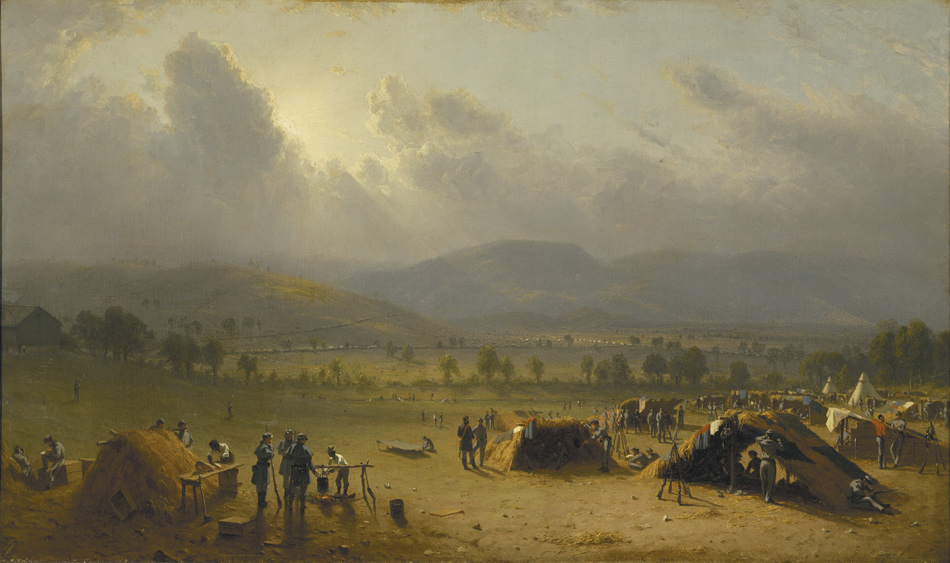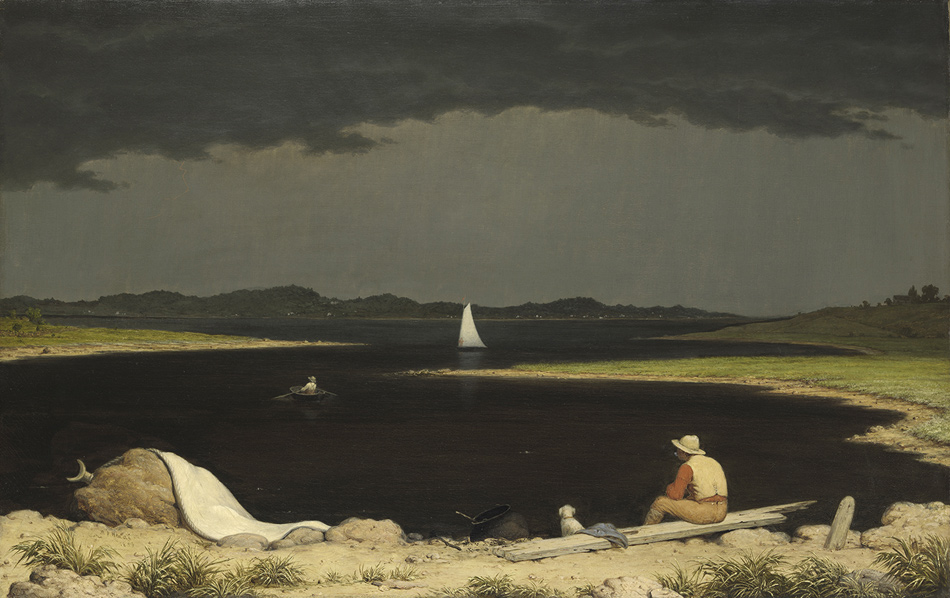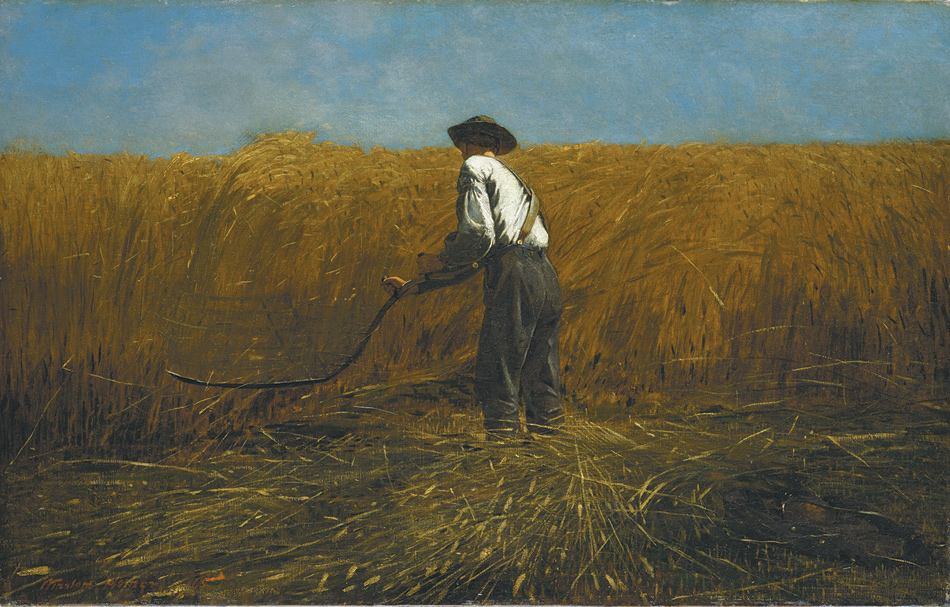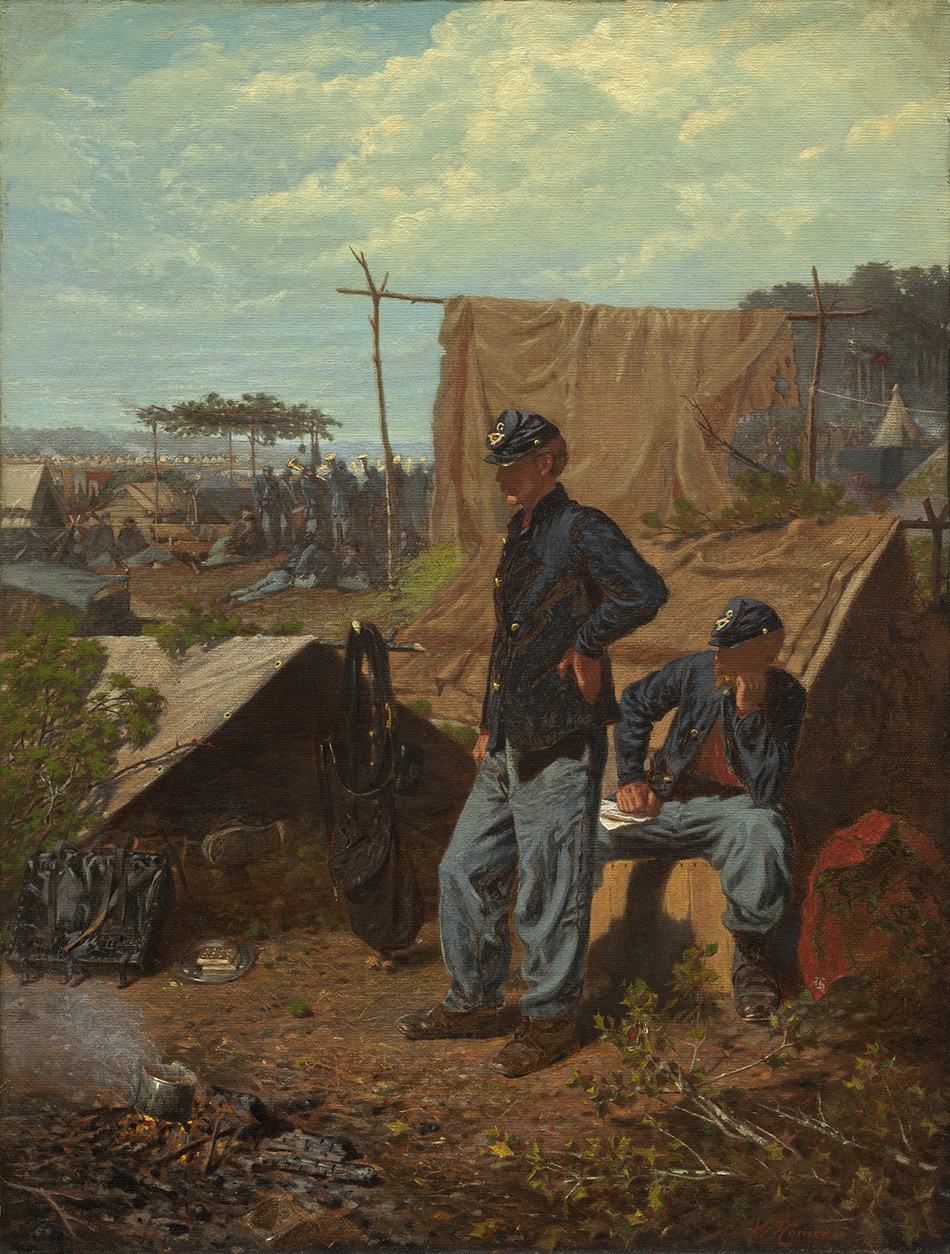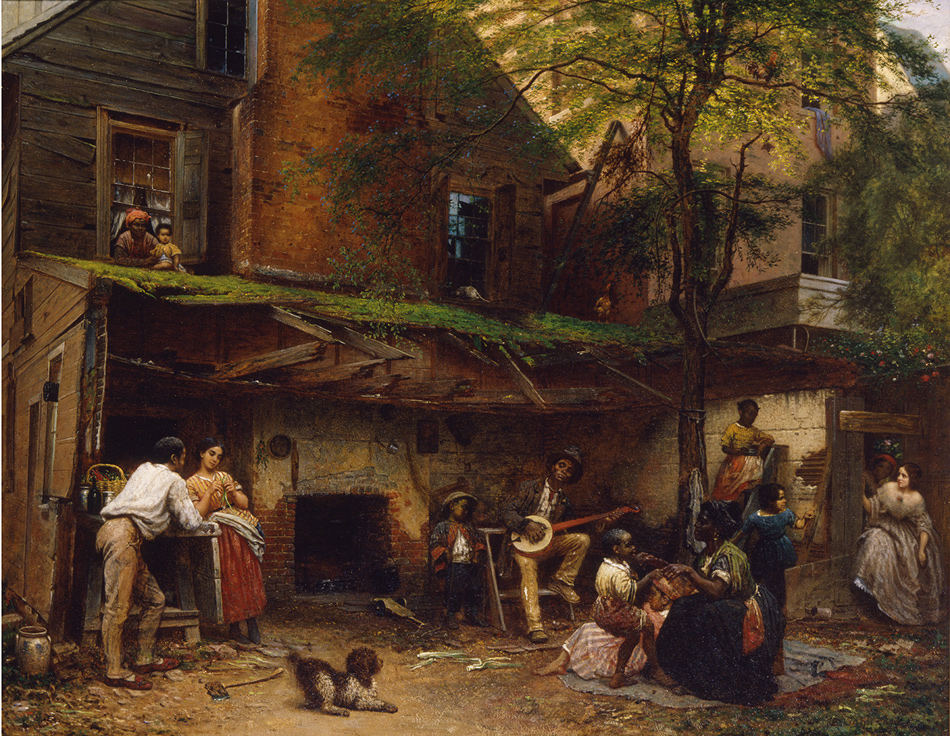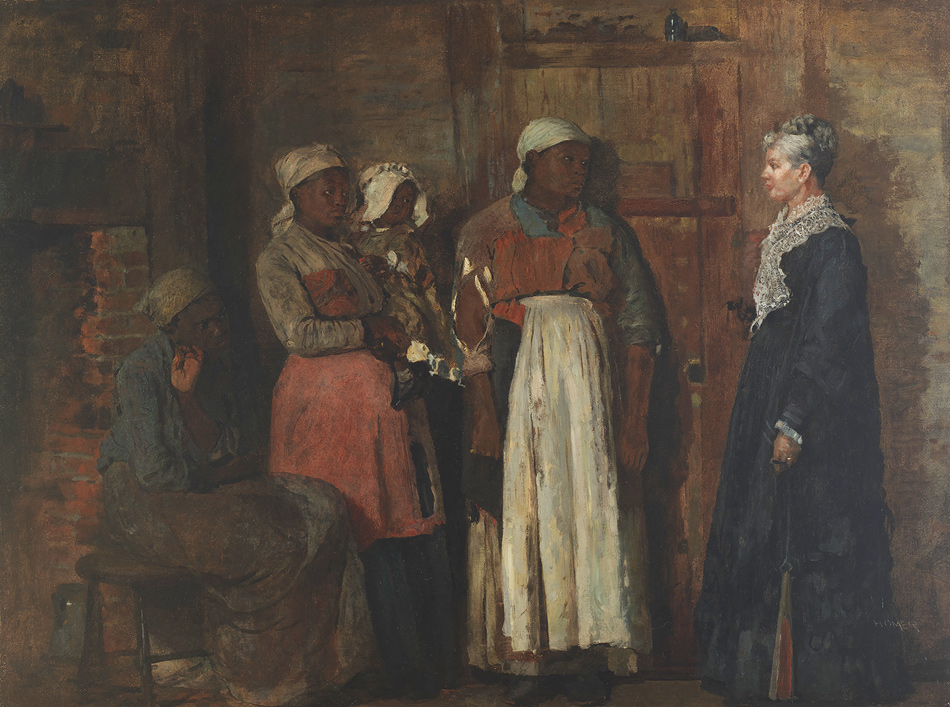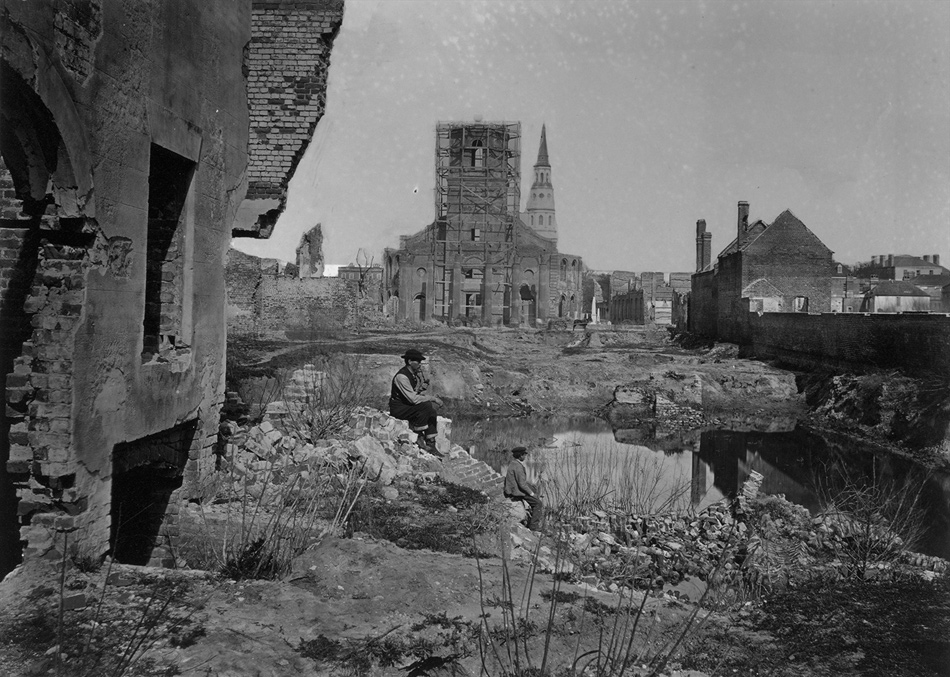Taken simply as an exhibition of paintings and photographs, the works that make up “The Civil War and American Art,” at the Smithsonian American Art Museum, form a muffled and somehow scattered, even numbing, display. In pictures that date from 1852 to 1877 but were mostly made during the war years, we see soldiers in camp, battlefields after the fighting, with dead infantrymen remaining to be buried, and the fortifications around the port of Charleston, South Carolina. There are scenes of the life of black people before and after the war, and, surprisingly, a good number of landscapes. They are of threatening weather or unusual developments in the sky—or are grandiose vistas of the Andes and the Arctic by Frederic Church or of Yosemite by Albert Bierstadt—and are to be seen as reflecting the moods of the moment. Considering how fraught, wounding, and dramatic an event the war has long been in our national consciousness, the exhibition feels anticlimactic. It has few commanding or affecting images of people. We walk away wondering where everyone is.
No war, of course, has an obligation to inspire works of art, let alone great ones, and a viewer can quickly become disgusted with himself or herself for finding the purely artistic results of the Civil War to be only moderately engaging. Probably few wars have compared with World War I in the art that emerged during and after it. Considerable amounts of sentimental and propagandistic work were, it is true, produced on both sides. Yet the war gave rise to paintings and sculptures of imaginative power by artists who were commissioned by their governments to record the events (notably Paul Nash) and by artists who were merely soldiers or onlookers at the time—figures such as Max Beckmann, Fernand Léger, Marsden Hartley, Walter Sickert, Otto Dix, Félix Vallotton, William Nicholson, E.L. Kirchner, Christopher Nevinson, and Wilhelm Lehmbruck. Lasting works were created about the nightmare of combat, bereavement in itself, and even the sheer physical exhilaration engendered by serving one’s country.
The circumstances of our Civil War were quite different. Given the still relatively youthful and exploratory state of American art in the middle of the nineteenth century, it is remarkable that any first-rate artworks were made at all. Few already established painters dealt directly with the topic, and no government agencies at the time, in Washington or Richmond, paid artists to document the events. Photography, then hardly beyond its nascent stage, was in the hands of people who were learning on the job what the camera’s capacities were in wartime. But the largest issue, commented on by observers, had to do with the fratricidal, and not always morally clear-cut, nature of the conflict. The war, which was initially expected to be decided quickly, and soon became, and remained for some three years, a colossal stalemate, causing undreamed of and unprecedented destructiveness, was in a sense an agony that didn’t give artists room to step back and comment on the events in personal ways.
There have, of course, been many books and exhibitions that documented the war’s battles and combatants and gave a sense, using photographs, paintings, and drawings made in the field, of what the era “looked like.” The present show is apparently the first, however, to pin down the effect the war had on artists—and by artists it essentially means the trained or professional figures who, with New York as the center of their operations, made up the art world of the day. Thus we are given none of the often subtle and sure-handed on-the-spot drawings of military actions (some of the best are by Alfred Waud and Edwin Forbes) and, also unfortunately, no paintings or sculptures by folk or self-taught artists. On the positive side, there are no standardized, presentation-piece portraits or boilerplate scenes of valiant regiments marching off to war or engaging the enemy.
The show was organized by Eleanor Jones Harvey, a curator at the Smithsonian American Art Museum and the sole author of the accompanying catalog. (Most museum publications of comparable size are made up of separate articles by different writers who are experts on aspects of the general subject.) A scholar who has written about Frederic Church, Harvey has been inspired by the scope of the war and by the issues of loss it brings up, in particular, as she writes, “the reaction to death” and “the point that no one escaped the war unscathed.” She has mastered an enormous amount of diverse information. Her catalog’s huge bibliography is divided into sections on art, photography, history, science and exploration, literature and music, and slavery and abolition, and she makes much of this material come across as a single, almost magisterial, story.
Advertisement
Harvey sees how the very nature of the Civil War created difficulties for artists. Her approach, though, is more literary and symbolical than aesthetic, and she believes that the works she has chosen present a kind of poetic narrative about America. Like other art historians and curators of nineteenth-century American art, she views landscape painting, particularly the heroic and romantic canvases of the Hudson River school (and of succeeding landscapists), as emblematic of the ways Americans thought about themselves and their country in the decades before the Civil War. What Harvey wants to tell here is how painters, in canvases that show destabilized skies and terrains, and then photographers, in their images of ravaged, corpse-strewn sites, recorded the loss of the “Eden” or “sanctuary” that the landscapists had shown the country to be.
Going on to the storylike paintings made by Winslow Homer and Eastman Johnson in these years, Harvey brings an even more pressing moral note to her descriptions. In the few pictures Homer made of life for blacks during the war and after emancipation, and in Johnson’s pictures of black people from the time, she sees artists who “demonstrate an acuteness of vision rare in American art.” Their stature, for her, has much to do with their showing black people to be “as complex as any white person” and their seeing how differences between the races, and between the North and the South, would not be easily resolved.
If only in the enormous amount of information she has smoothly brought together, Harvey’s book will probably stand for some time as the authoritative word on the subject. Yet she works from assumptions about the strengths and weaknesses of nineteenth-century American art that are debatable. Caught up in the momentousness of the era she is dealing with, moreover, she finds political and cultural resonances in paintings and photographs that, judged as art, as objects on a wall, simply do not support such acclaim. And, irritatingly, she seems to believe that when the story inherent in a picture is fleshed out, or when the possible symbolism in a picture is brought to light, there is no more to say.
Martin Johnson Heade’s 1859 Approaching Thunder Storm, for example, where we see a man seated by an inlet, looking out at a big sky that is becoming frighteningly dark, is in the show because “perceptive viewers” at the time saw pictures like it being about the incipient collapse of the Union over slavery—what Lincoln had in mind when, in 1860, he referred to a “coming storm.” With its few clear, strong colors, its brilliantly convincing presentation of a sense of menace in the air, and the way the space of the scene is expressed in a number of serene, expanding curves, Approaching Thunder Storm is one of the truly distinctive nineteenth-century American paintings. It is easily the strongest picture in the exhibition. Whether Heade was making a point about the climate of his nation, however, remains a matter of conjecture, even considering the fact that the picture was owned by Noah Schenck, a known abolitionist preacher.
The trouble with seeing images of coming storms as harbingers of the war is that American landscape artists were handling the theme long before the war, during it, and after it. One of Heade’s other extraordinary works, Thunder Storm on Narragansett Bay, which also presents the moment before a deluge (and is not in the show), is dated 1868. Was he thinking in this instance, three years after the war’s end, about legislation looming in the South that would one day segregate blacks from whites? But the larger point is that when artworks are as satisfyingly full as Heade’s paintings of the moments before a storm, we don’t want to see them—some of us almost literally cannot absorb them—as carriers of themes that have no apparent relation to the scene at hand. The notion shrivels the work.
When Harvey asks us, in turn, to see allusions to the imperiled state of the nation in the works by Church that are in the exhibition—most of them mammoth, splashily colored, and intricately detailed panoramas of icebergs, or double rainbows in the mountains, or erupting volcanoes—the situation is different. It is hard to care one way or another. Church may have been a wizard of technique, and for many he seems to be a fixture of our art. But his major efforts are like travelogues—ponderous and obvious ones. Allusions could be found in them to virtually anything, and we would still be looking at artifacts.
Harvey tells how a Church showstopper from 1861 called The Icebergs, which was about the allure of the Arctic (and came from a trip to Newfoundland and Labrador), was retitled “The North.” Church’s Picture of Icebergs when it was shown in New York in April of that year—the point being to connect the painting to the unfolding national crisis. When the unsold work went to London in 1862, its title reverted to The Icebergs, because the British audience had mixed feelings about the cause of “the North.” The picture is in the exhibition because its history illustrates the way the wartime drama and Church’s art came together. But isn’t the story primarily about marketing?
Advertisement
With some of the paintings in the show by Sanford R. Gifford, though, we are given a taste of the actual event. Gifford’s presence is a pleasant surprise. He was an accomplished landscape painter whose chosen theme was distant views suffused by a misty, often golden atmosphere. But throughout his abbreviated career (he died in 1880, at fifty-seven) he attempted to bring little figures into his vistas, and he rarely did a better job of it than in the intimately sized pictures here of soldiers and civilians standing about, listening to a Sunday morning sermon in a field near Washington, in May 1861, and of Union soldiers setting up camp in July 1863, near Frederick, Maryland (see illustration on page 16).
The paintings are of Gifford’s own unit, the New York Seventh Regiment National Guard, which was called up for short tours in the first three years of the war (and whose home, from 1880, would be the Park Avenue Armory). When you look up the Seventh on Wikipedia, the picture you see, of an unidentified soldier, is Gifford. His May 1861 scene transports us to a highly specific moment, at once blithe and tense: the capital in the weeks after Fort Sumter has been fired on, and a conflict of some kind seems to be a reality, but before the First Battle of Bull Run (which would come in July), when a grimmer reality emerged. Gifford’s pictures from 1863, in which the Seventh is setting up camp, are even better. He has made his figures slightly bigger, and it is a joy to follow the seemingly nonchalant yet precise way he has brushed in his long-limbed soldiers, their tents, their laundry hung out to dry, and, as Harvey points out, himself sketching.
Beautifully crisp handling of paint is what we expect from Winslow Homer, the artist most associated with the war. Twenty-five years old in 1861, he followed the conflict as a sketch artist for Harper’s Weekly, and the first paintings he ever made were scenes from the front. Homer may be best known for his later pictures of the pounding sea and Maine coastal life, but in his finest early paintings, whether of army life or, after the war, of courting rituals and rural ways, he was a sharp-eyed social observer. He was a dramatist of sorts, too, and already in Home, Sweet Home (circa 1863) and The Veteran in a New Field (1865), which are among the stronger works in the exhibition, he was making pictures in which the viewer is invited to puzzle out what is going on in the scene and titles are part of the experience of the works.
The soldiers in Home, Sweet Home, seen before their tent and fire, have made a makeshift “home” for themselves and are no doubt thinking of their real one. The veteran, who we see from the rear, cutting down a wall of wheat before him with his scythe, is at a moment in his life when his past and present are wildly different yet inseparable. Ambiguously, he works his crop in a way that might recall what he did when he was in uniform. Homer even suggests that the farmer, while fortunate to have survived the war, is—in his hunched posture and homely little hat—diminished by being replanted in his field.
Homer’s work of this time lends itself to Harvey’s way of examining all the details and nuances in a picture and pulling from them a message. She holds us as well when deciphering related paintings by Homer’s contemporary Eastman Johnson. Her description of his large Negro Life at the South (1859)—a stage set–like scene, in the backyard of a house in Washington, with little groups of black people here and there—freshly recreates the dilemmas of the slave system.
Johnson, a New Englander, was an abolitionist in his sympathies, but his life changed when, in 1857, his father, a widower, remarried into a slaveholding family (which was descended from George Washington). Harvey shows how the artist’s personally compromised position, and the compromised position of the whole nation, is mirrored in Negro Life. In the picture, the slaves’ house abuts the house of their owner, and Johnson’s theme is this sordid and festering closeness. The key actor in his tableau is a young woman. She is seen cautiously stepping from the master’s house into the slaves’ yard from a nearly hidden little door connecting one world with the other. She at first appears to be a white visitor but, as Harvey puts her finger on the various clues, is probably mulatto, and is at home nowhere.
The drawback to Harvey’s careful and even suspenseful analysis of Negro Life and of other paintings by Johnson is that few of these complexities are alive to us as we look at his pictures. Unless we are studying them in a book, with an interpretation printed alongside, Johnson’s paintings come across as products of a bygone time. The most distinctive aspect of his art is his feeling for brown. He has more shades of it than you knew existed.
The Winslow Homer of Harvey’s pages also seems to be something of a fantasy. For Harvey, the painter reacted to the “war’s brutality” with “anguish and sympathy.” She believes that a “sense of tragic loss permeates much of Homer’s wartime oeuvre.” She sees, further, in the handful of pictures he made around 1876 of black people—such as A Visit from the Old Mistress, where an impassive white woman faces her former slaves, who look back undemonstratively—a “deeply thoughtful” awareness of the problems facing blacks and whites after emancipation.
But Homer’s work in the show is not, as Harvey puts it, “monumental” in feeling, and she is on thin ice in telling us what concern or cause he was espousing in this or that scene. He was famously tight-lipped about himself and his goals throughout his life. Nor do the words “sense of tragic loss” mesh with the spirit of the pictures he did of camp life. The best are more like accounts of men making do in trying circumstances. By temperament, Homer seems less a “tragic” creator than a stylish and dryly ironic one. He surely put as much artistic energy into recording the clothes people wore as in making statements about his society’s ills, and when he shows a black person looking wary or apprehensive this doesn’t automatically lend the work a rich undertow of feeling. In the vaguely distrustful visages he can give the black and the white characters in his pictures he might be saying something about his own insistent need for privacy.
No one can question the tragic and brutal nature of the Civil War. But Harvey overrates the degree to which artists, in their work, were not only consumed by the events but desirous of seeing them in loftily tragic ways. In her presentation of the photography of the time, one wonders if, with her heightened concern for the suffering caused by the war—and her belief that the American land itself was the preeminent subject for the American artist in these years—she has not slanted the subject somewhat. The twenty-odd photos she has chosen present almost exclusively devastation, whether they are of dead soldiers left on the fields after Antietam and Gettysburg or the ruined condition of Charleston and Columbia and of sites in Georgia after Sherman swept through them. There are very few living people in these pictures. They all present land (and city streets) marked by loss.
Harvey wants us to see that these wrenching photos, which apparently received much attention in the press when they were shown to the public during the war, represented, to the photographers, the artistic side of their work. It is valuable to learn this. In her chapter on the subject, though, Harvey doesn’t make clear how these men, including Mathew Brady, Alexander Gardner, and George Barnard (who followed Sherman’s campaign), saw themselves as artists.
We hear about how Gardner, say, “artfully” worked to show Lincoln towering over General McClellan and his staff when the president went to the front after Antietam. But it is hard, looking at the photo, to see what Gardner’s artistry was. Lincoln was simply taller than most of his contemporaries. Without denying their industry or heroism—or, in Barnard’s case, the gripping clarity of his images—mightn’t the photographers be seen just as accurately as entrepreneurs who looked to current notions of “fine art” in order to elevate their fledgling endeavor?
The Civil War, as it happened, generated an enormous and many-sided body of photographs. And when one goes through the various collections of photos of the era, including Gardner’s Photographic Sketch Book of the Civil War (1866), which Harvey cites—or the excellent 1952 Divided We Fought: A Pictorial History of the War, 1861–1865, which has a running commentary by the historian David Donald—one can be overwhelmed by the variety and intensity of the hundreds of shots. In these books the pictures of the war dead and of bombed-out Southern places are simply part of the flow of images. They are of a piece with photos of a drum corps or the 4th US Colored Infantry posing for its picture, or of captured Confederates waiting for what happens next—or of Grant stopping to talk with a member of his Council of War as the rest of the Council, sitting on pews that have been taken outdoors from a church, read the paper, smoke, or glance at the photographer.
In Divided We Fought, there are pictures of dead soldiers at a distance from us, as Harvey presents them; but there are also startling close-ups of dead soldiers. Would the photographers have felt that these extraordinary images were merely documents but their pictures of fields with corpses were works of art? There are photos in the book as well for which we are totally unprepared. An image of a few Union soldiers seen from the rear, sitting on a rise as they look out over a camp at Cumberland Landing, could almost be, in its gracefulness and spontaneity, by Henri Cartier-Bresson. Or we encounter a transfixingly elegant photograph of three officers of the 1st Connecticut Artillery standing by a tree, with the one in the middle reading a piece of paper as his fellows look into the distance. Like the picture of the soldiers at Cumberland Landing, it turns on its head the notion that when we look at photographs we are taken into the past.
The point is not that there is a show’s worth of Civil War art that Harvey has ignored. My sense is that she has ably culled what little traditionally conceived art the conflict produced. But visual work of great expressivity, it turns out, is rarely to be found in the fine art of the time. Images full of character and emotion can be seen, though, in many of the photo portraits of officers and enlisted men in a book like Divided We Fought. Their faces bespeak the adamancy, plaintiveness, and frozen blankness that had to have been much in evidence at the moment. Walking through the Smithsonian’s collection after seeing Harvey’s show, I was struck, in turn, by an anonymous folk carving of Stephen A. Douglas, a principal player in the era if not the war (the senator died in 1861). With his darkened, secretive eyes, this bullish and demonic figure embodies the bursting energies of the time and of folk art itself (and suggests why curators are loath to mix it in with traditional mainstream art).
The photographs of Lincoln also put us in touch with a vital drama of some sort. As Harvey notes, the president was interested in having his picture taken throughout his career. Over a hundred photos of him survive, the majority perhaps done during his years in the White House. In the engrossing and beautifully printed The Face of Lincoln (1979), we see, from picture to picture, a wry, devious, impatient, unusually gawky, bemused, and sometimes quite formidable man, ending with the well-known late close-up of a softly smiling president. The images show a born performer, and make clear, you might say, that life as well as death is a part of war.


